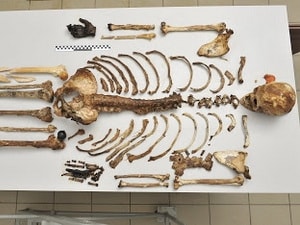New DNA technology decodes mysterious deaths
Polish scientists said on January 14 that new DNA testing technology could help restore at least part of the identity of people who left no images behind after death.
The new technology, called HirisPlex, has helped scientists determine the eye and hair colors of unknown victims of the Nazi era. It has also helped identify a mysterious woman buried alongside monks in a medieval crypt.

(Source: AFP)
“This system can be used to resolve historical disputes where color photographs and other documents are not available,” said Wojciech Branicki of the Institute of Forensic Science in Krakow, Poland.
The new system is a revamped version of tools already used to assess the DNA codes that tell us about eye and hair color. It can also be used with teeth and bones, which retain DNA for longer periods than soft tissue.
Writing in the scientific journal Investigative Genetics, the researchers said they initially tested a tooth taken from the body of General Wladyslaw Sikorski, who led Poland's government-in-exile in Britain during World War II before dying in a plane crash in 1943.
Sikorski's body was buried in a cemetery in Newark, England, and was reburied in Krakow in 1993. In 2008, his grave was exhumed again to test a theory that Sikorski had been poisoned, shot, or suffocated.
Genetic analysis of his teeth showed a 99% chance that Sikorski had blue eyes and an 85% chance that he had blond hair. Both match contemporary descriptions of Sikorski and paintings of him made years after his death (no color photographs of him survive).
HirisPlex also helped confirm the partial identities of 12 people who died in a prison in Nazi-occupied Poland in 1942 and whose names were never known. Their skulls were sent to Vienna, where they are on display at the city’s Natural History Museum.
DNA results from the skulls showed that these people likely had brown eyes, and hair ranging from brown to blond, a finding consistent with typical Polish people.
A third test sheds light on the mystery at a Benedictine monastery in Tyniec, near Krakow, where archaeologists discovered the bones of two women alongside 17 other skeletons believed to be male monks. Tests of one of the samples showed the woman had brown eyes and blond or brown hair./.
According to (Vietnam+) - VT
